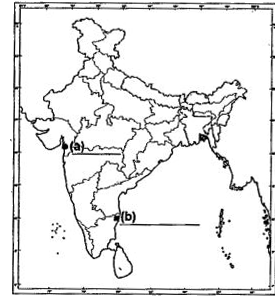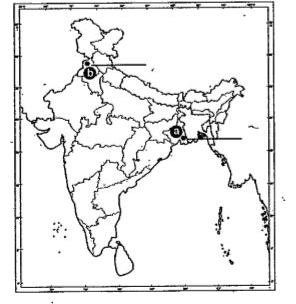Through various National Movements, Gandhiji mobilized public support to win freedom for India. In this context, state the following:
The name given to the uprising of 1942. Two reasons for launching this mass uprising.
Two reasons for launching this mass uprising include:
(i) Japanese threat : The Japanese Army had attacked Burma(Myanmar) and was marching towards Assam. Gandhiji and other leaders were convinced that this situation called for complete independence from the British immediately. So, they decided to launch a movement upon the British to quit India.
(ii) Failure of the Cripps Mission: The Hindu Mahasabha rejected the proposals because it feared the partition of the country. The people of the Princely States had no right to send their representatives to the proposed constitutionmaking body. Their representatives were to be selected by the rulers. The Congress was opposed to the principle of non-accession of the provinces. Gandhiji opposed the declaration and urged the working committee to reject it. Mahatma Gandhi described the Cripps. proposals as a .post-dated cheque on a failing bank.
Similar Questions
Through various National Movements, Gandhiji mobilized public support to win freedom for India. In this context, state the following:
Any three causes for Gandhi to launch the NonCooperation Movement ?
View SolutionThrough various National Movements, Gandhiji mobilized public support to win freedom for India. In this context, state the following:
The impact of the Non-Cooperation Movement in India's freedom struggle.
View SolutionThe Quit India Resolution in 1942 was one of the final calls given by Gandhi for the Britishers to leave India. Moving towards Independence, Lord Mountbatten's Plan was significant. In this context, answer the following:
State two reasons for the launching of the Quit India Movement.
View SolutionThe Quit India Resolution in 1942 was one of the final calls given by Gandhi for the Britishers to leave India. Moving towards Independence, Lord Mountbatten's Plan was significant. In this context, answer the following:
Give any three effects of the Quit India Movement launched by Gandhi in 1942 that was significant to the last phase of the National Movement of India.
View SolutionWith reference to the Mass Phase of the National Movement under the leadership of Gandhi, answer the following:
State any three reasons for the launching of the Quit India Movement.
View SolutionIn 1930 Mahatma Gandhi's demands were rejected by the British, as a result of which he launched the Civil Disobedience Movement. In this context explain the following:
Name the famous march undertaken by Gandhiji. Where did he begin this march ? State two of its features.

View SolutionTwo features a and b are marked on the given political outline map of India. Identify these features with the help of the following information and write their correct names on the lines marked near them:
a. The place associated with the Civil Disobedience Movement 1930.
b. The place wher the Indian National Congress Session was held in 1927.

View SolutionLocate and label any four of the following with appropriate symbols on the same given political outline map of India.

Note : The following questions are for the visually impaired candidates only in lieu of Q. No. Attempt any six questions.
Name the State where the session of Indian National Congress was held in 1920.
Name the State where the movement of Indigo planters was started.
Name the State where the Jallianwala Bagh massacre occured.
Name the state where Sardar Sarovar Dam is located.
Name the State where Bhilai Iron and Steel plant is located.
Name the State where Pune Software Techonology Park is located.
Name the State where Kochi 'Sea Port' is located.
Name the State where Indore cotton textile industry is located.
View SolutionChallenges of Nation Building-'Sardar Vallabhbhai Patel and National Integration'
The first Deputy Prime Minister and Home Minister of India, Sardar Vallabhbhai Patel, emerged as a major leader of the freedom movement after the Kheda Satyagraha (1918) and the Bardoli Satyagraha (1928).
At the time of independence, the problem of integration of princely states was a big challenge for the national unity and integrity of India. Under such difficult times, Sardar Patel undertook the daunting tasks of uniting all 565 princely states of India. Known as an 'Iron Man' of India, Patel's approach to the question of the merger of princely states into independent India was very clear. He was not in favour of any compromise with the territorial integrity of India. By his political experience, diplomatic prowess and foresightedness, out of India's 565 princely states many had already given their consent to merge with India even before achieving the independence. Sardar Patel faced key challenges of integration from three states, viz., Hyderabad, Junagarh and Kashmir. It was under his leadership that Indian forces compelled Hyderabad and Junagarh to merge with India. Being well-versed with Pakistan's intentions from Jinnah's divisive "Two Nation Theory, Sardar Patel's opinion on Kashmir was different from other leaders. Like Hyderabad, he also wanted Kashmir's integration with India through military operations. But due to political decisions of some prominent leaders, Sardar could not succeed in integrating Kashmir fully with India which later turned into a major historical blunder for the country. However, Patel will always remain as an astounding leader who combined in himself the features of a true Nationalist', 'Catalyst' and 'Realist - popularly characterised as NCR in Indian political history.
Name the leader who played an important role after the Kheda Satyagraha and the Bardoli Satyagrapha (1928).
View SolutionTwo features (a) and (b) are marked on the given political outline map of India. Identify these features with the help of the following information and write their correct names on the lines marked on the map
(i) The place where the Indian National Congress Session was held
(ii) The city where 'Jallianwalla Bagh' incidence took place

View Solution
